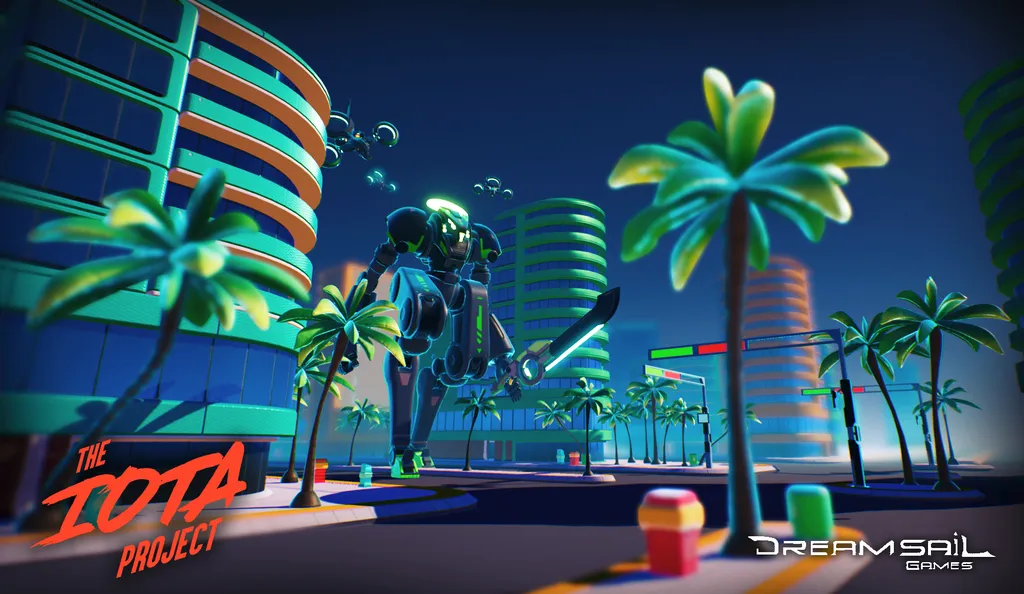Playing The Iota Project just a few weeks after reviewing Archangel feels like some sort of strange coincidence. As I worked through Skydance Interactive’s fun but flawed on-rails mech game, I kept noticing several opportunities for new gameplay styles and user interface interactions that went unexplored. Almost exactly a month on from my review, though, I’m playing something that seems to have crawled inside my brain and taken all those ideas for itself, and I couldn’t be happier about it.
The Iota Project is the debut VR project from DreamSail Games, on its way to the Oculus Rift and HTC Vive. It’s only been in the works for around four months, but it already shows signs of becoming VR’s best mech action game.
The demo I’ve played for the game is very similar in structure to the early build of PowersVR; there’s an open-world environment to explore, but it’s essentially a sandbox designed to introduce you to the game’s mechanics rather than offering any missions or objectives. It’s hard to care when you’re too busy punching planes from the sky and engaging in giant sword battles, though.
First off, The Iota Project gives you full control over locomotion, either from the Oculus Touch’s control sticks or the Vive wand’s track pad. You stand on a platform inside your mech, which imitates your arm movements, much like in Pacific Rim. With your controllers you can make a fist for punching enemies, grab and throw surroundings objects like trees and cars, or aim two laser-targeted rocket launchers.
These base mechanics are a joy to mess around with. Carelessly swinging my arms into buildings to bring them toppling down and picking up cars to use as shields is enormously entertaining. The red laser targets that extend from your arms are an appreciated bonus over Archangel’s aiming reticles, although still somewhat awkward to master. I wonder if it would be easier to allow players to aim based on where their actual hand is pointing, rather than trying to align the laser targeting with enemies in front of you.
The Iota Project doesn’t just limit itself to the buttons on your controller though. At the front of your mech is a virtual console of sorts with three other attacks. One is a shockwave that sends enemies flying, while another unleashes a barrage of missiles that tear anyone in the way to pieces. Finally, there’s an immensely satisfying laser beam that’s controlled by your head movements. These all recharge over time, meaning they’re best used in tight spots.
This deadly concoction of options makes The Iota Project something of a dream come true for mech combat fans. There are two enemy types in the demo, including a flying drone and a mech that stands shoulder-to-shoulder with your own. They’re easily dispatched, but the fun is in how you do it. Robotic fist fights offer silly thrills, as does flinging cars into pesky drones, but the real laughs come from hitting the shockwave and watching nearby foes sent flying. If you want to be uber-cool, you can even find swords on the ground to pick up and slash through fiends with.
The only question is how will DreamSail channel this playground of possibilities into something that still challenges players in a fair way. I found my health bar would deplete from rocket attacks fairly quickly, though plentiful health pick ups staved off death with little worry. This is a demo, so the absence of threat can be forgiven, but the balance between fun, challenging gameplay and not slowing progress to a halt as you defend yourself is a delicate one to master.
On the technical side there are some understandable early setbacks. Draw distance is very short, for example, stretching out for no more than 50 meters or so before the screen is covered in a shroud of mist. Buildings also don’t always crumble in the exact way you’d expect them to, removing some of the satisfaction of clearing them out of your path. Also there were a lot of times that, in my excitement, I accidentally hit weapons buttons when I didn’t mean to. There’s plenty of time to clean these aspects up, though.
I’m really looking forward to seeing how DreamSail builds The Iota Project from here. This is a very promising proving ground for the game’s combat mechanics, but the structure built around it will dictate how it translates into a full game.
DreamSail Games is planning to release a public demo of The Iota Project within the next few weeks, and I suggest you give it a look. Stay tuned for more on the full game.


























